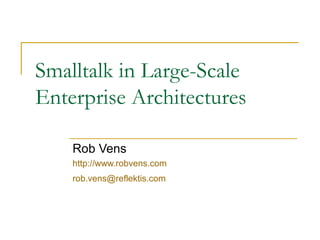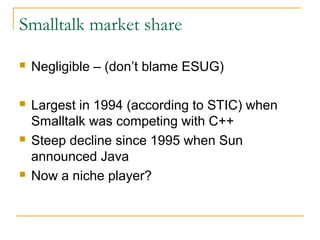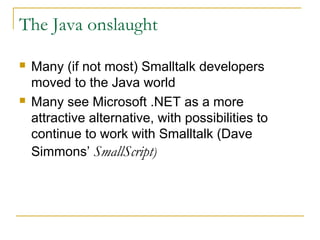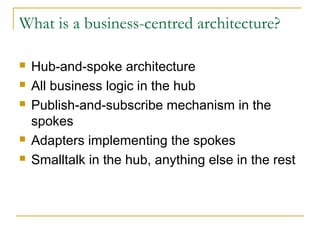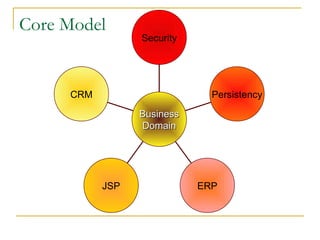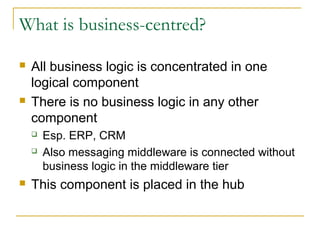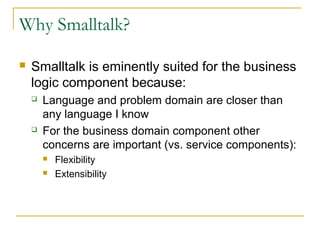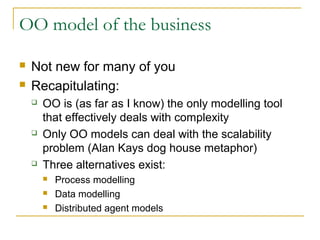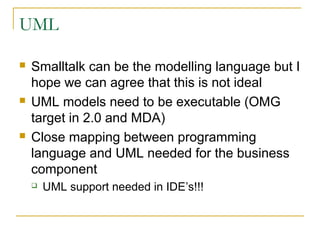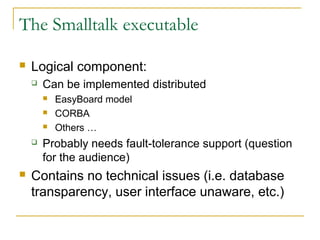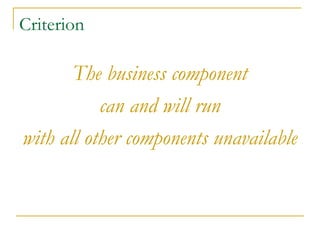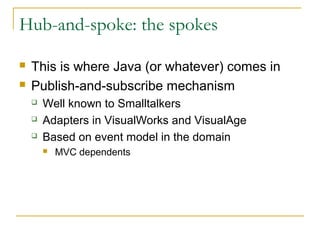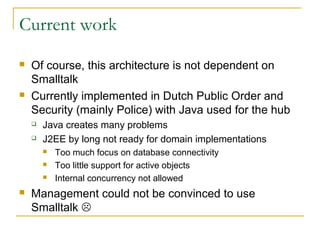Smalltalk in large scale enterprise architectures
- 1. Smalltalk in Large-Scale Enterprise Architectures Rob Vens http://www.robvens.com rob.vens@reflektis.com
- 2. Traditional Smalltalk Applications ´ü« Client-Server ´ü« Fat client ´ü« GUI intensive
- 3. Recent developments ´ü« Web enabled ´ü« Using web standards ´ü▒ HTML ´ü▒ XML ´ü▒ Soap ´ü▒ WDSL ´ü▒ UDDI ´ü« Poor support for distribution, connectivity (i.e. with Java and J2EE)
- 4. Smalltalk market share ´ü« Negligible ÔÇô (donÔÇÖt blame ESUG) ´ü« Largest in 1994 (according to STIC) when Smalltalk was competing with C++ ´ü« Steep decline since 1995 when Sun announced Java ´ü« Now a niche player?
- 5. Can you sell Smalltalk to your management? ´ü« Proven technology is what they want ´ü« If itÔÇÖs not Java itÔÇÖs not modern ´ü« Or the old arguments: ´ü▒ Smalltalk is slow ´ü▒ Too pure OO ´ü▒ Object-orientation has failed
- 6. The Java onslaught ´ü« Many (if not most) Smalltalk developers moved to the Java world ´ü« Many see Microsoft .NET as a more attractive alternative, with possibilities to continue to work with Smalltalk (Dave SimmonsÔÇÖ SmallScript)
- 7. But there is another alternative ÔǪ ´ü« Basic idea is to use Smalltalk as an Enterprise Application Integrator (EAI) ´ü« Several architectures are possible to do this ´ü« I will propose a business-centred architecture
- 8. What is a business-centred architecture? ´ü« Hub-and-spoke architecture ´ü« All business logic in the hub ´ü« Publish-and-subscribe mechanism in the spokes ´ü« Adapters implementing the spokes ´ü« Smalltalk in the hub, anything else in the rest
- 10. What is business-centred? ´ü« All business logic is concentrated in one logical component ´ü« There is no business logic in any other component ´ü▒ Esp. ERP, CRM ´ü▒ Also messaging middleware is connected without business logic in the middleware tier ´ü« This component is placed in the hub
- 11. Why Smalltalk? ´ü« Smalltalk is eminently suited for the business logic component because: ´ü▒ Language and problem domain are closer than any language I know ´ü▒ For the business domain component other concerns are important (vs. service components): ´ü« Flexibility ´ü« Extensibility
- 12. Characteristics of the domain component 1. There is an OO model of the business 2. This model is a Roger Rabbit model 3. The model is written in UML 4. It is implemented in Smalltalk as an executable 5. It attempts to be an exact replica of the business in software ÔÇô a kind of simulation model
- 13. OO model of the business ´ü« Not new for many of you ´ü« Recapitulating: ´ü▒ OO is (as far as I know) the only modelling tool that effectively deals with complexity ´ü▒ Only OO models can deal with the scalability problem (Alan Kays dog house metaphor) ´ü▒ Three alternatives exist: ´ü« Process modelling ´ü« Data modelling ´ü« Distributed agent models
- 14. Roger Rabbit models ´ü« Also called: ÔÇ£active objectsÔÇØ ´ü« What is active in the ÔÇ£realÔÇØ world is passive in the model and vice-versa ´ü« Business processes unfold in a backward- chaining process of objects delegating responsibilities (Responsibility Driven Design, CRC sessions) ´ü« Process model is a ÔÇ£pull modelÔÇØ ´ü« ÔÇ£Out of ControlÔÇØ
- 15. UML ´ü« Smalltalk can be the modelling language but I hope we can agree that this is not ideal ´ü« UML models need to be executable (OMG target in 2.0 and MDA) ´ü« Close mapping between programming language and UML needed for the business component ´ü▒ UML support needed in IDEÔÇÖs!!!
- 16. The Smalltalk executable ´ü« Logical component: ´ü▒ Can be implemented distributed ´ü« EasyBoard model ´ü« CORBA ´ü« Others ÔǪ ´ü▒ Probably needs fault-tolerance support (question for the audience) ´ü« Contains no technical issues (i.e. database transparency, user interface unaware, etc.)
- 17. Modelling issues: Simulation science ´ü« The running executable is like a running simulation ´ü« Executable models need to deal with dynamic behaviour, esp.: ´ü▒ Waiting lines ´ü▒ Stochastics ´ü« Smalltalk has deep roots in simulation!
- 18. Criterion The business component can and will run with all other components unavailable
- 19. Hub-and-spoke: the spokes ´ü« This is where Java (or whatever) comes in ´ü« Publish-and-subscribe mechanism ´ü▒ Well known to Smalltalkers ´ü▒ Adapters in VisualWorks and VisualAge ´ü▒ Based on event model in the domain ´ü« MVC dependents
- 20. Links between hub and spokes ´ü« Events out, messages in ´ü« No direct dependencies between business component and ÔÇ£outside worldÔÇØ
- 21. Current work ´ü« Of course, this architecture is not dependent on Smalltalk ´ü« Currently implemented in Dutch Public Order and Security (mainly Police) with Java used for the hub ´ü▒ Java creates many problems ´ü▒ J2EE by long not ready for domain implementations ´ü« Too much focus on database connectivity ´ü« Too little support for active objects ´ü« Internal concurrency not allowed ´ü« Management could not be convinced to use Smalltalk ´üî
- 22. Thank you
Editor's Notes
- #8: DonÔÇÖt sell Smalltalk ÔÇô sell itÔÇÖs strengths. Use the standard technologies for the technical areas. IT is growing up: this means that emphasis will be less on technical issues, and will move to business alignment.
- #9: Hub-and-spoke and bus architectures are the two most important logical architectures in EAI (Enterprise Application Integration). Bus architectures are generally considered to be more scalable, but these architectures typically put a messaging component in the critical location. anything else of course means J2EE or .NET currently.
- #10: What we will try to achieve is maximum reuse and maximum business alignment. This is difficult with many large scale enterprise tools such as CRM software. The strategy here is to use the software ÔÇô but avoid to implement business logic in it. Or if you do make sure it is an easily adaptable replica of the ÔÇ£realÔÇØ business logic component in the centre.
- #12: We might say that Smalltalk is used as a business modelling language. DonÔÇÖt sell Smalltalk: sell business modelling.
- #13: But  business modelling is not business modelling. There are various strategies here. Use OO for what its best in: reducing complexity in large models. Modelling is an art. Technology is not. This is the critical component, but I argue that for large companies this can be done with a relative small group.
- #14: Most systems I see use one of the first two of the metaphors. Distributed agent model are becoming popular, but are mainly seen in the academic area.
- #15: Usually complex business processes are not modelled as such. They are generated. The stratum from which they arise is the object infrastructure which decides, on an ad-hoc basis, what the ÔÇÿbestÔÇØ sequence of events will be to do the thing needed. The thing needed is a responsibility of an object, for example: An insurance policy that want to sell itself A ship in a harbour that wants to unload A criminal that wants to arrest himself Notice that objects in the model are active, while passive in the real world and vice-versa. This is a pattern. It is just a modelling trick, which reduces complexity. ÔÇ£Pull modelsÔÇØ is an industry term. Look for this on the web. Also called DTO (deliver-to-order). This is typical backward chaining process generation.

